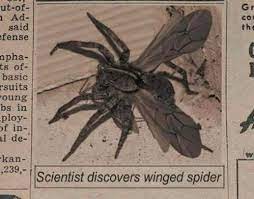
Flying Spiders! (Physics behind it)
An introduction to Flying Spiders! (Physics behind it)
Name: Own Teacher
Email: info@ownteacher.com
Created At: 28-10-2023
"Flying spiders" is a term used to describe the behavior of certain spider species that appear to fly or glide through the air using silk threads. While they don't truly "fly" in the way birds or insects do, this behavior is a fascinating example of passive aerial locomotion. Here's a full explanation of the physics behind this phenomenon:
Silk Production: Flying spiders, like many spider species, produce silk using specialized glands in their abdomen. This silk is incredibly strong and lightweight, making it an excellent material for various purposes.
Ballooning Behavior: To engage in aerial dispersal, spiders climb to a high point, extend one or more silk threads into the air, and release fine silk filaments. These silk threads are lifted into the air by a combination of electrostatic forces and wind.
Electrostatic Forces: The silk threads develop a static electric charge due to friction between the spider and the silk as it's extruded. This charge can interact with charged particles in the atmosphere, leading to repulsion and liftoff.
Wind Currents: Wind currents in the atmosphere play a crucial role in the spider's "flight." The silk threads act as sails, catching the wind and allowing the spider to be carried through the air. The spider doesn't have direct control over its movement and is essentially at the mercy of the wind.
Passive Flight: This form of aerial locomotion is passive; the spider doesn't actively flap wings or exert force for propulsion. Instead, it relies on external factors like wind and air currents.
Atmospheric Conditions: The success of this behavior depends on various atmospheric conditions, including wind speed and direction. Spiders are more likely to engage in ballooning during specific weather conditions, such as warm, sunny days with light winds.
Ecological Significance: Flying spiders use this behavior for dispersal and migration. It allows them to move to new locations, find mates, and colonize new habitats. It's an important part of their life cycle and ecological role.
Biomechanics and Silk Properties: The biomechanics of silk production, the design of the silk threads, and their aerodynamic properties are critical factors that enable this phenomenon. The silk threads are designed to be lightweight and strong, providing a balance between staying aloft and remaining durable.
In summary, the "flying" behavior of spiders using silk threads is a remarkable example of passive flight in the animal kingdom. It relies on the production of silk, electrostatic forces, wind currents, and favorable atmospheric conditions. This behavior is essential for spider dispersal, allowing them to explore new territories and contribute to the ecological balance in various ecosystems.
Comment List
Leave a Comment.



